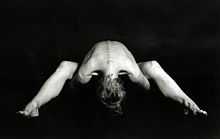Kurmasana

Kurmasana (koohr-MAH-sah-nah;[1] Sanskrit pronunciation: [kuːɹmɐːs̺ɐn̺ɐ]; Sanskrit: कूर्मासन; IAST: kūrmāsana), Tortoise Pose,[2] or Turtle Pose[3] is an asana.
Etymology
The name comes from the Sanskrit words Kurma (कूर्म, Kūrma) meaning "turtle" or "tortoise"[4] and Asana (आसन, Āsana) meaning "posture" or "seat".[5]
Description
To enter kūrmāsana a practitioner sits with the legs outstretched, feet as wide apart as possible. The knees are bent slightly, keeping the heels in contact with the floor. The body is leaned forward from the hips and the hands slid under the knees. The body leans forward (bending at the hips) to allow the hands and arms to slide sideways and backward (under the knees) until the elbows lie near the back of the knees. The heels are pushed forward and legs straightened as much as possible. The forehead or chin is brought to touch the floor. The arms are further brought around the back to interlock the hands under the buttocks.[6]
Variations
Variations of Kūrmāsana include:
- Supta Kūrmāsana(Sleeping Tortoise Pose)[7]
- Ardha Kūrmāsana (Half Tortoise Pose)[8]
- Uttana Kūrmāsana (Upside-Down Tortoise Pose)[9]
See also
References
- ↑ Budilovsky, Joan; Adamson, Eve (2000). The complete idiot's guide to yoga (2 ed.). Penguin. p. 215. ISBN 978-0-02-863970-3. Retrieved 11 April 2011.
- ↑ Gray 2008, p. 59.
- ↑ Ramaswami 2005, p. 77.
- ↑ "Kurmasana - AshtangaYoga.info". Retrieved 2011-04-11.
- ↑ Sinha, S.C. (1 June 1996). Dictionary of Philosophy. Anmol Publications PVT. LTD. p. 18. ISBN 978-81-7041-293-9. Retrieved 9 April 2011.
- ↑ Saraswati 1996, p. 328.
- ↑ "Supta Kurmasana - AshtangaYoga.info". Retrieved 2011-04-11.
- ↑ "Bikram Yoga College of India - Ardha Kurmasana - Half tortoise pose". Retrieved 2011-04-11.
- ↑ "Yoga Stretch: Uttana-Kurmasana Upside-down Tortoise". Retrieved 2011-04-11.
Sources
- Ramaswami, Srivatsa; Krishnamacharya, T. (2005). The Complete book of Vinyasa Yoga: An authoritative presentation, based on 30 years of direct study under the legendary yoga teacher Krishnamacharya. Da Capo Press. ISBN 978-1-56924-402-9. Retrieved 11 April 2011.
- Gray, Alexandra (2008). The Yoga Teacher. Grove Press. ISBN 978-0-8021-7055-2. Retrieved 11 April 2011.
- Saraswati, Swami Satyananda (1996) [1969]. Asana Pranayama Mudra Bandha (Third revised edition ed.). Munger, Bihar, India: Yoga Publications Trust. ISBN 81-86336-14-1.
Further reading
- Saraswati, Swami Janakananda (1 February 1992). Yoga, Tantra and Meditation in Daily Life. Weiser Books. ISBN 978-0-87728-768-1. Retrieved 11 April 2011.
- Saraswati, Swami Satyananda (1 August 2003). Asana Pranayama Mudra Bandha. Nesma Books India. ISBN 978-81-86336-14-4. Retrieved 9 April 2011.
- Saraswati, Swami Satyananda (January 2004). A Systematic Course in the Ancient Tantric Techniques of Yoga and Kriya. Nesma Books India. ISBN 978-81-85787-08-4. Retrieved 9 April 2011.
External links
| ||||||||||||||||||||||||||||||||||||||||||||||||||||||||||||||||||||||||